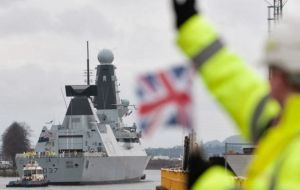MercoPress. South Atlantic News Agency
Royal Navy forced into “cannibalization” to meet the shortage of spares
 The Royal Navy has 19 frigates and destroyers and seven attack submarines - but at times they lack the spare parts they need to go to sea.
The Royal Navy has 19 frigates and destroyers and seven attack submarines - but at times they lack the spare parts they need to go to sea. The Royal Navy seems to be copying some of its Latin American peers. In effect the shortage of spares for Royal Navy warships and submarines has forced the Ministry of Defense (MoD) to strip parts from the rest of the fleet, the National Audit Office (NAO) has found.
An NAO investigation found equipment “cannibalization” had increased by 49% over the past five years. The spending watchdog warned that the practice was costing the MoD millions of pounds and delayed construction.
The MoD said components were only swapped when “absolutely necessary”.
Currently, the Navy has 19 frigates and destroyers and seven attack submarines - but at times they lack the spare parts they need to go to sea. NAO said building the third Astute class submarine, HMS Artful, was delayed by 42 days because parts were taken during its construction - adding nearly £5m to the overall cost.
The vessel, built in Barrow in Cumbria, completed its maiden dive in 2014
NAO found that, last year, there were 795 instances when spare parts had to be removed from one vessel and given to another - the equivalent of 66 a month, up from 30 a month in 2005.
Between April 2012 and March 2017, there were 3,230 instances involving 6,378 parts, their investigation found. The NAO report noted that in some circumstances, such as during high-intensity operations, cannibalisation could be the most effective way to keep vessels at sea.
But it said it also increased costs. NAO said the MoD itself had identified that cannibalization had affected submarines currently in production “leading to an estimated £40m cost increase”.
The watchdog said cuts to the maritime support budget, along with the MoD's failure to monitor the practice, had exacerbated the problem.“In the past two years, the Navy has removed an estimated £92m from its maritime support in-year budgets,” the report said.
A Ministry of Defense spokesman said: “Less than 0.5% of parts we use come from swapping components, and we only do this when it's absolutely necessary to get ships out of port and back on to operations more quickly. We continue to make improvements to how we manage this long-established practice.”




Top Comments
Disclaimer & comment rules-

-

-

Read all commentsThis has been happening for decades.
Nov 01st, 2017 - 10:30 am +3I can remember visiting RAF Wattisham about 30 years ago and talking about serviceability of the ageing Phantom fleet. The Chief Technician said that they had to cannabalise parts from aircraft with short airframe lives to keep the fleet flying. pares were non existent.
The same with the Harriers. Their life span had been shortened due to intensive use in Iraq.
Not enough spare parts had been ordered from the manufacturers so they were raiding the RAF museum to remove parts from the exhibits to keep the Harrier force flying.
This seems to be endemic with the MOD ordering an supply chain and costs more in the long run.
This sort of activity has always gone on in the services, its nothing new. Having worked in companies making military equipment its a bit of a cash cow. When the equipment was first built parts would be made in batches which reduces set up costs per item. But if someone orders a single replacement part later on the item costs much more because it carries the whole setup cost instead of a small part of it. This plus the tendency to put a huge markup on spares makes single spares very expensive. Thats why it makes sense to raid defunct equipment for spares.
Nov 01st, 2017 - 02:41 pm +3This concept of borrowing parts is worldwide. It's nothing new or alarming...
Nov 01st, 2017 - 04:43 pm +3Commenting for this story is now closed.
If you have a Facebook account, become a fan and comment on our Facebook Page!